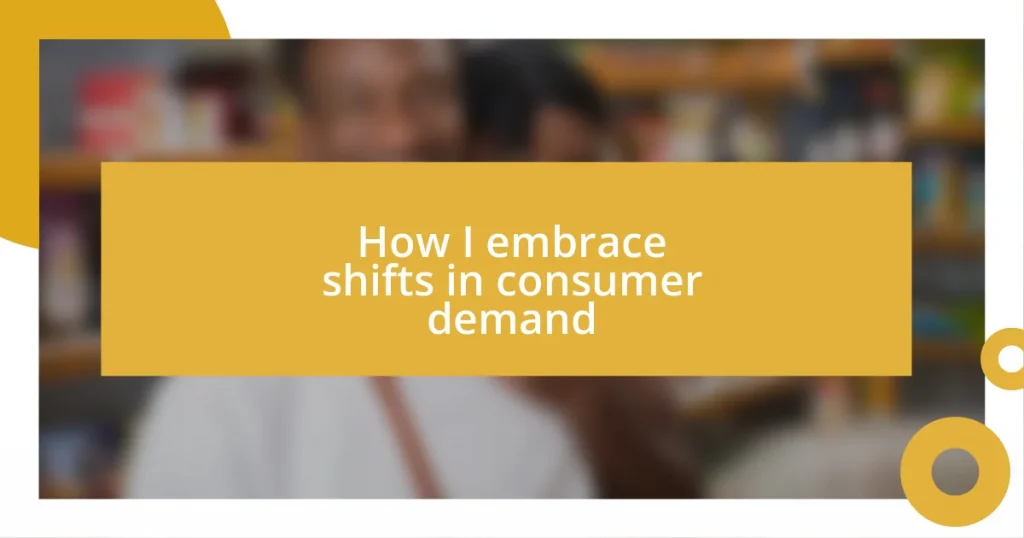Key takeaways:
- Understanding consumer behavior shifts, especially during the pandemic, underscores the importance of adaptability in brand strategies and prioritizing emotional drivers like health and safety.
- Engaging with consumers through feedback mechanisms and data analytics facilitates timely marketing adaptations, leading to more relevant campaigns and stronger brand connections.
- Innovation in products and services is driven by direct consumer engagement and insights, allowing for personalized offerings that align with shifting consumer values, such as sustainability.
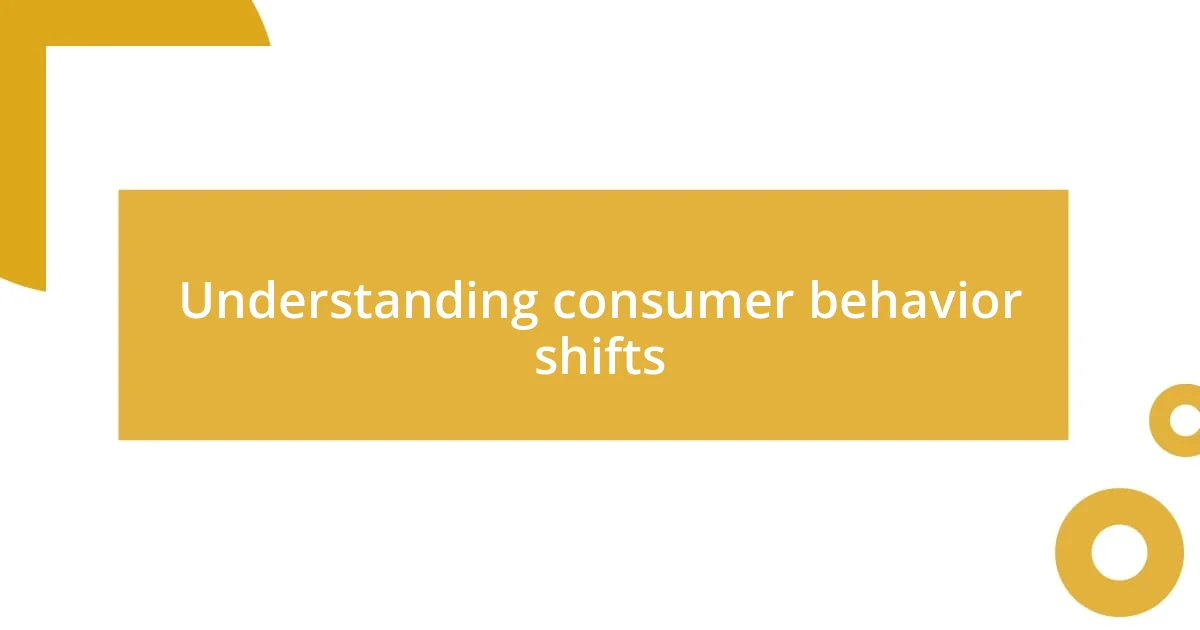
Understanding consumer behavior shifts
Understanding consumer behavior shifts is essential for anyone looking to stay relevant in the marketplace. I remember when the pandemic shifted how people viewed convenience—online shopping became a lifeline for many. Have you ever paused to think about how quickly we adapted to virtual interactions? This was more than just a trend; it reflected a fundamental change in priorities and lifestyles.
As I delved deeper into consumer trends, I noticed emotional drivers at play. For instance, health and safety became paramount, influencing choices from food purchases to clothing. It made me realize that understanding what consumers genuinely value can shift brand strategies dramatically. Are you paying attention to the emotional landscape of your audience? Empathy, I’ve found, is a powerful tool in deciphering these behavioral changes.
Moreover, generational shifts also play a crucial role in shaping consumer behavior. When I see Gen Z prioritizing sustainability over price, it challenges the old paradigms I was used to. Isn’t it fascinating how younger consumers demand more transparency and ethical practices from brands? This shift teaches us to innovate constantly and adapt our approaches, or risk being left behind.
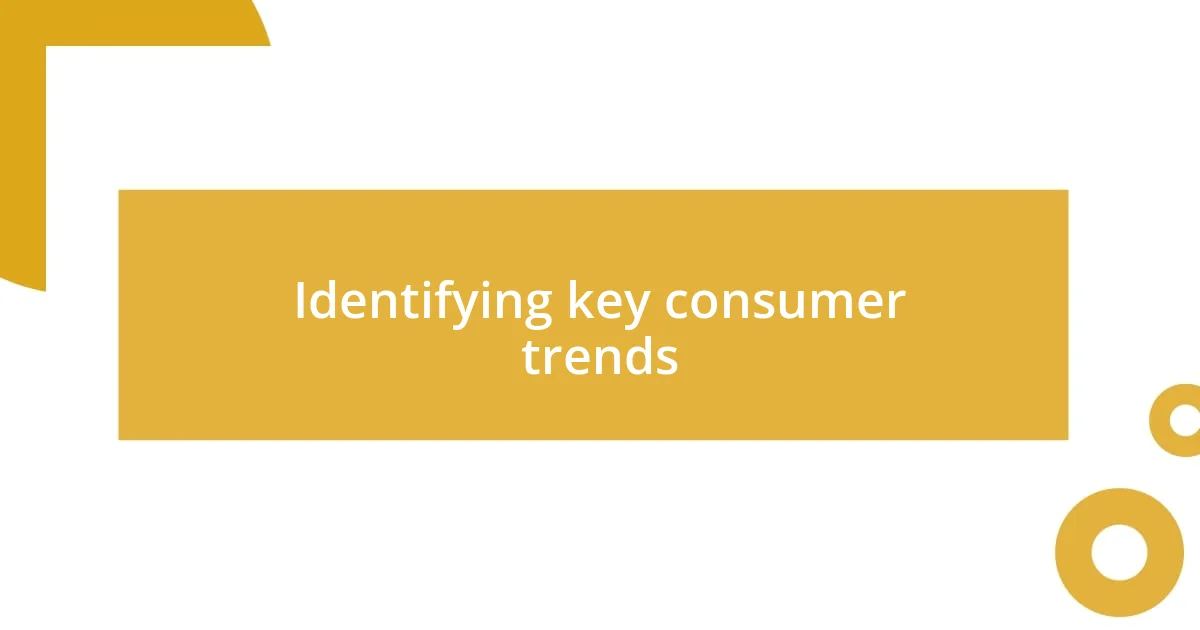
Identifying key consumer trends
To effectively identify key consumer trends, I find it crucial to keep my ears to the ground and genuinely listen to what people are saying. During my time attending trade shows, I often caught snippets of conversations that hinted at shifting priorities. For instance, I remember overhearing a group discussing their newfound interest in eco-friendly products, underlining how sustainability was creeping into everyday choices. This experience reaffirmed my belief that consumer preferences are constantly evolving, and paying attention to these subtle cues can unearth valuable insights.
Here are some specific trends I’ve identified that highlight shifting consumer behavior:
- Growing emphasis on health and wellness, motivating consumers to seek organic and nutritious options.
- Increasing demand for transparency, where consumers want brands to openly share sourcing and production practices.
- Rise in online community engagements, affected by social media platforms shaping collective buying decisions.
- An uptick in personalized experiences, where consumers expect brands to cater uniquely to their preferences and needs.
- Shift towards local products as consumers become more invested in supporting local businesses.
Embracing these trends has not only helped me refine my strategies but also understand that consumer demands are often reflections of broader societal changes.
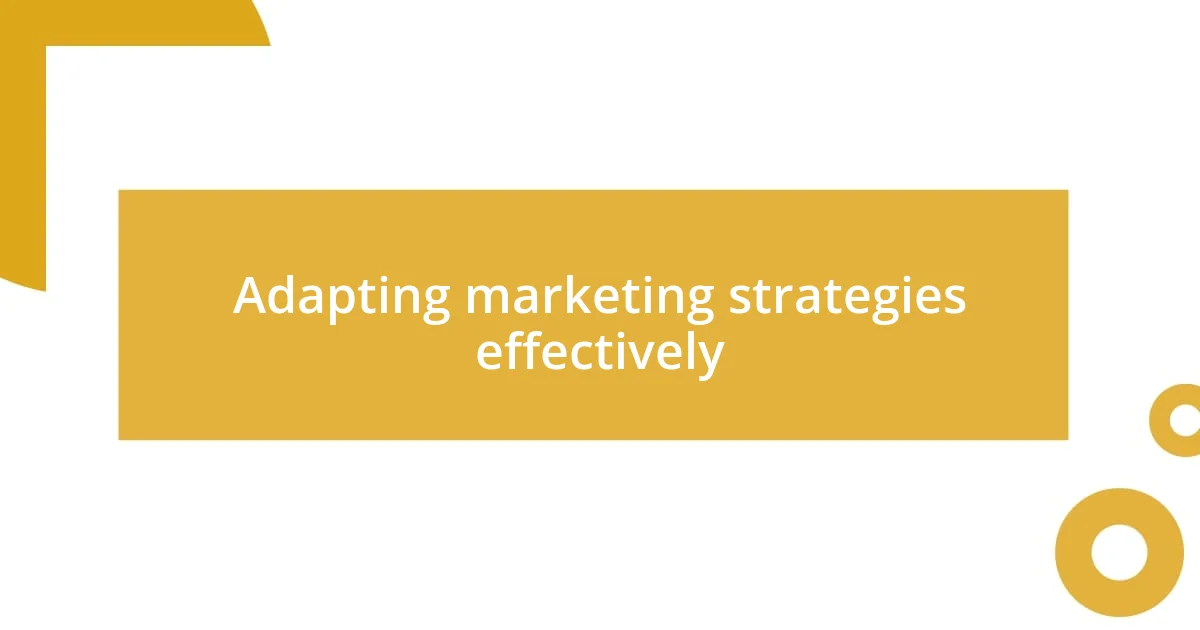
Adapting marketing strategies effectively
Adapting marketing strategies requires a keen sense of timing and a willingness to pivot. I recall a situation where my team was about to launch a campaign for a travel product just as travel restrictions hit. Instead of scrapping the project, we recalibrated our approach to focus on virtual travel experiences. This not only made the content relevant but also engaged audiences seeking escapism from their homes. Have you ever had to change course mid-journey? It can be daunting, but it often leads to innovation that resonates more profoundly with consumers.
Flexibility in marketing allows brands to experiment and learn. I remember launching an online survey to gauge shifting preferences among my audience during a significant market change. The feedback revealed unexpected interest in DIY activities and home improvement, which was a goldmine. By shifting our content strategy to focus on these emerging trends, we cultivated stronger connections with our audience. It’s a reminder that sometimes, the best strategies come from direct engagement. What would it look like to actively include your audience’s voice in shaping your marketing direction?
Moreover, leveraging data analytics has become indispensable for tracking these shifts. When I integrated AI tools to analyze consumer behavior patterns, I was astonished by the insights gained. For instance, we discovered spikes in product interest correlating with social media trends. This allowed us to adjust our marketing budget dynamically, investing more where the demand was strongest. I learned that data is not just numbers; it’s a narrative waiting to be understood. How well are you interpreting the story your data tells?
| Strategy | Example |
|---|---|
| Identify Shifts | Launch surveys and polls to gather consumer insights |
| Pivot Campaigns | Recast messages to resonate with current consumer needs |
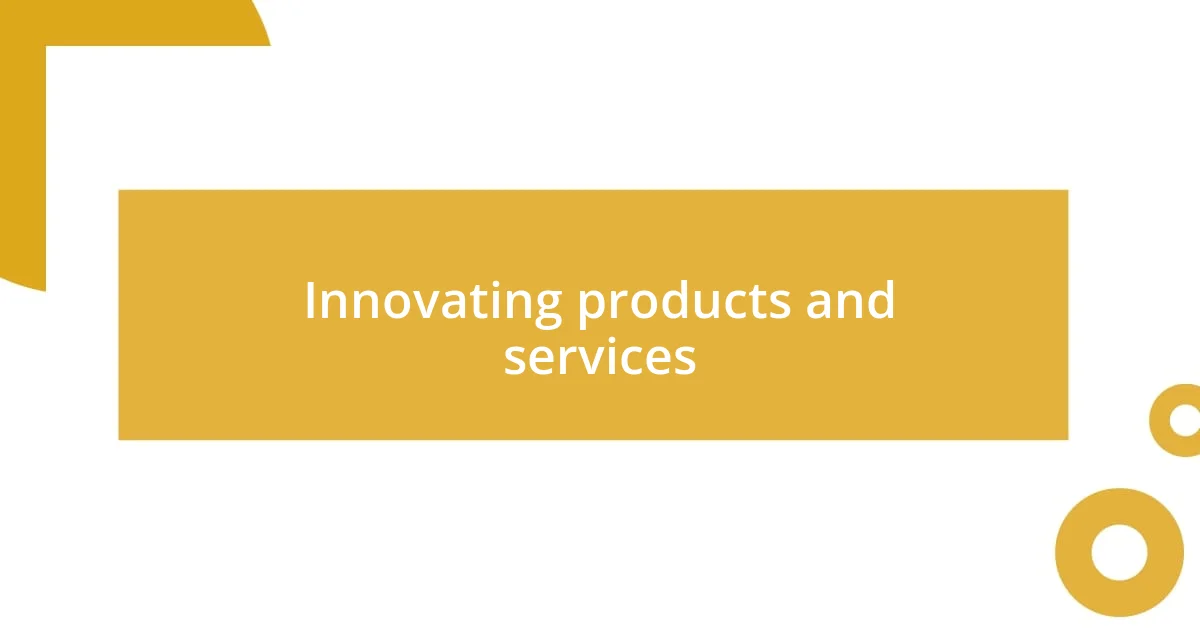
Innovating products and services
When innovating products and services, I draw from my own experiences with what truly resonates with consumers. I remember developing a health food snack after noticing a customer lamenting the lack of tasty, nutritious options at a local event. By engaging directly with potential users and incorporating their feedback, we crafted a product that exceeded their expectations. Isn’t it fascinating how a simple conversation can lead to innovation that perfectly aligns with consumer desires?
Another time, I experimented with creating customizable features for a service I offered, allowing customers to tailor their experience. The reaction was overwhelmingly positive; it seemed that people loved having control over their choices. This sparked a thought: how often do we overlook the power of personalization? It’s a lesson I learned firsthand: truly innovative products stem from understanding what consumers want and giving them a voice in the process.
Moreover, staying ahead means continuously reassessing existing services. I once revamped a product line after a thorough analysis highlighted shifting consumer interests toward sustainability. This involved not only redesigning the product but also sourcing materials through ethical suppliers. I was both excited and nervous about the shift—what if our loyal customers didn’t embrace the changes? However, their enthusiastic responses showed me that innovation authentically rooted in consumer values can cultivate loyalty and excitement. Have you ever considered how reassessing your offerings might reveal untapped potential?
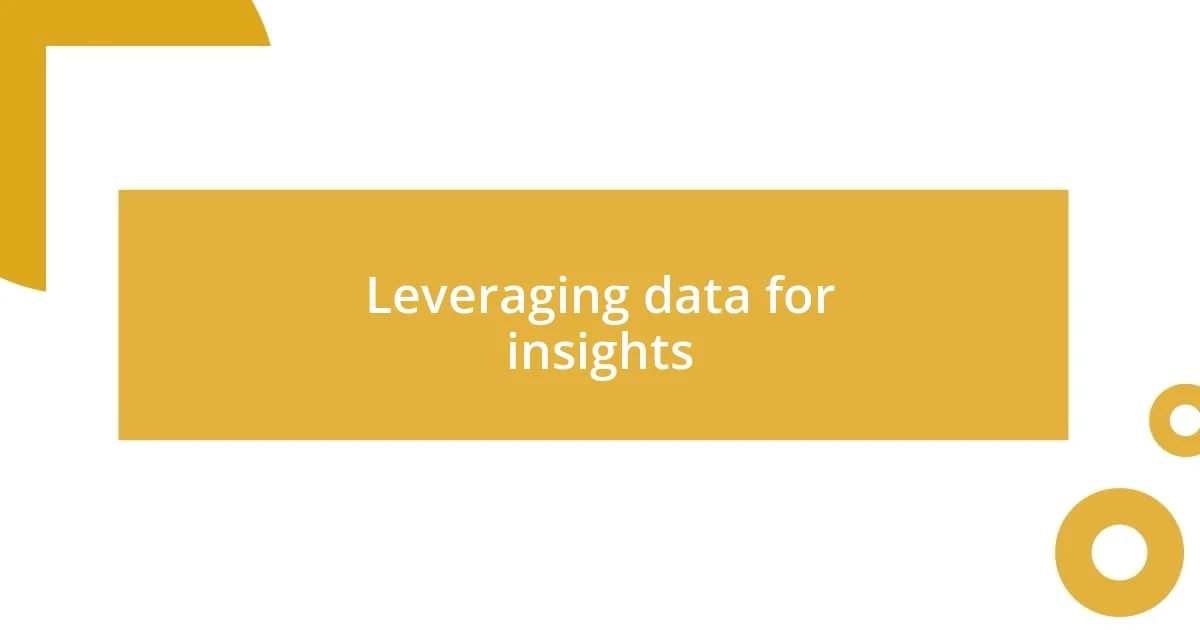
Leveraging data for insights
Leveraging data effectively has transformed the way I approach consumer insights. For instance, I started monitoring website analytics closely, and I was blown away by how visitor behavior patterns unfolded like a story. One week, people spent more time surfing product pages related to eco-friendly options, igniting my curiosity. This shift encouraged me to delve deeper, prompting questions: What drives these interests? The answers guided my next campaign, increasing conversions and making our messaging feel more relevant.
An experience that stands out was when I used sentiment analysis on social media to grasp consumer feelings about our brand. I found that while many loved our products, there was also a wave of critique regarding customer service. This insight pushed me to rally my team for a customer service overhaul. It’s amazing how diving into consumer sentiments can lead to not just better engagement but also a stronger brand image. Have you thought about how the right data can illuminate the path to improvement?
I also remember employing A/B testing in a recent marketing initiative, which was an eye-opener. By presenting two different email subjects, I discovered one resonated far better with my audience. What amazed me most was how a simple adjustment led to a notable increase in open rates and conversions. It made me realize the power of being data-driven—sometimes, minor tweaks based on analytical insights can yield monumental results. Are you ready to explore how small changes, rooted in data, can enhance your strategies?
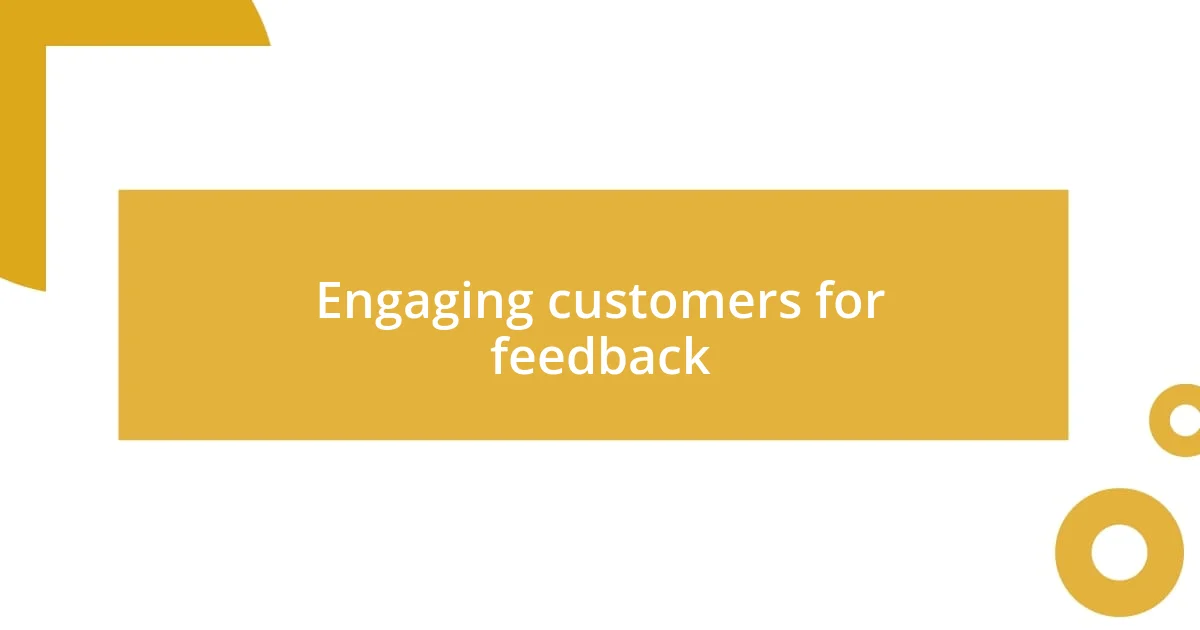
Engaging customers for feedback
Engaging customers for feedback is a cornerstone of my approach. I remember hosting a small focus group where I invited a handful of regular clients to share their thoughts on a new service concept. Their candid feedback, filled with enthusiasm and criticism alike, illuminated aspects I hadn’t even considered. It struck me—how often do we miss out on valuable insights just because we forget to ask?
I also made it a point to incorporate customer surveys post-purchase, which has turned out to be a treasure trove of information. One particular survey led to a heartwarming response from a customer who felt a strong connection to our brand story. Knowing that our narrative resonated with someone on a personal level encouraged me to double down on authenticity in our messaging. Have you ever paused to reflect on how deeply your brand message can impact your audience?
In addition to structured feedback, I frequently engage with customers through social media. I cannot tell you how many transformative ideas emerged from casual conversations in the comments. For example, a casual comment about wanting more sustainable packaging turned into a brainstorming session that not only inspired a new initiative but also fostered a sense of community among our followers. Isn’t it incredible how a simple exchange can spark innovation and create lasting relationships with customers?
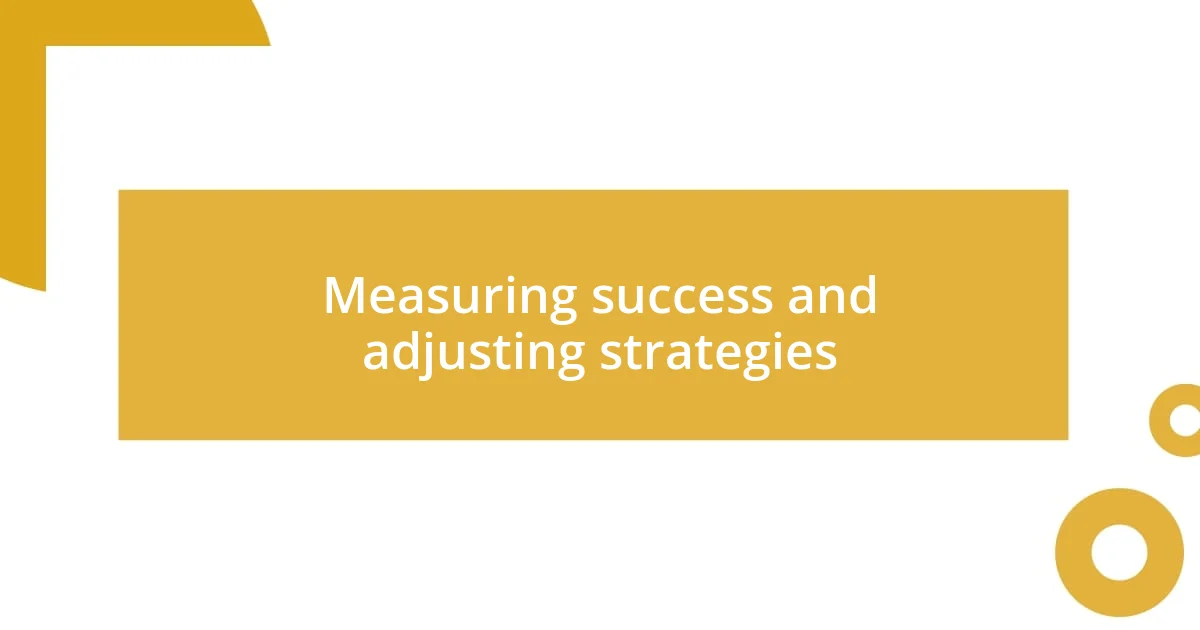
Measuring success and adjusting strategies
To measure success effectively, I rely heavily on key performance indicators (KPIs) that align with my shifted strategies. One memorable instance was after launching a new line of products, where I observed a sharp increase in online traffic but minimal engagement. It hit me hard—was my messaging missing the mark? This realization led me to reassess not only the promotional content but also the target audience, resulting in a strategy that resonated more deeply with potential customers. What about you? Have you ever had a moment of clarity that turned your direction around?
Adjusting strategies is not just a reactive process for me; it’s inherently proactive. I fondly recall a quarterly meeting where we reviewed our social media engagement metrics. The surprising dip in interaction compelled me to pivot our content strategy towards more interactive posts. That shift not only refueled our audience’s interest but also created a more vibrant community around our brand. In my experience, aligning your team’s strategies with real-time feedback creates a sense of ownership and motivates everyone involved. Have you noticed how team collaboration enhances responsiveness to changing needs?
On a broader level, I find that market trends often serve as a guiding compass for strategic decisions. I vividly remember tracking sales data during a holiday season. Patterns emerged that highlighted an unexpected preference for bundled offers over individual items. Embracing that insight allowed me to tailor our promotions effectively, leading to a record-breaking season. Isn’t it fascinating how consumer preferences can shape an entire marketing approach? By staying attuned to these shifts, I truly believe we can create more valuable connections with our customers.










